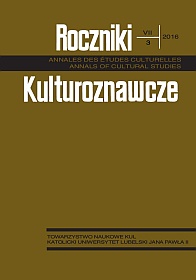Robots, Slaves, and the Paradox of the Human Condition in Isaac Asimov’s Robot Stories
Abstract
Slaves and robots have in common that they are intended to obey orders. Therefore I suggest taking a close look at some of Isaac Asimov’s robot stories. Executing a program while detecting and overcoming problems and acting towards fulfillment of given instructions—all this makes a robot a perfect slave. In the same way as slave laws in the British Colonies in America were intended to keep slavery effective by confining slaves in their place, so are Asimov’s Three Laws of Robotics the formal condition for the workability of a robot holding society. Asimov’s androids reveal the implicit impossibility of both robots and slaves by establishing the command structure that would be needed to keep the system working and then disassembling this structure. The Three Laws, as they are meant to guarantee protection, command, and operation, cannot possibly work with separate master/slave subjects. They are a paradoxical juxtaposition. And consequently, slavery is logically impossible.
References
Ady, John, Anthony Benezet, and John Drinker. The Case of Our Fellow-Creatures, the Oppressed Africans Respectfully Recommended to the Serious Consideration of the Legislature of Great-Britain. London, Philadelphia: reprinted by Joseph Crukshank, 1784.
Anderson, Susan Leigh. “Asimov’s ‘Three Laws of Robotics’ and Machine Metaethics.” AI & Society 22, no. 4 (2008): 477–93, doi: 10.1007/s00146-007-0094-5.
Anderson, Susan Leigh. “Asimov’s ‘Three Laws of Robotics’ and Machine Metaethics.” In Science Fiction and Philosophy: From Time Travel to Superintelligence, edited by Susan Schneider, 259–76. Chichester: Wiley-Blackwell, 2009).
Asimov, Isaac. Robot Dreams. New York: Ace Books, 2004.
Asimov, Isaac. The Complete Robot. London: HarperCollins, 1995.
Blum, Paul Richard. “The Immortality of the Soul,” in The Cambridge Companion to Renaissance Philosophy, edited by James Hankins, 211–33. Cambridge: Cambridge University Press, 2007.
Clark, Andy, and David J. Chalmers. “The Extended Mind,” Journal (Paginated), Analysis, (1998), http://cogprints.org/320/
Clarke, Roger. “Asimov’s Laws of Robotics: Implications for Information Technology.” In Machine Ethics, edited by Michael Anderson and Susan Leigh Anderson, 254–84. New York: Cambridge University Press, 2011.
Gisondi, Marcello. “Ma gli androidi leggono Kant? Le leggi della robotica: un possibile percorso epistemologico dalla letteratura al diritto.” ISLL Papers The Online Collection, 209-216, 6 (2013), https://www.academia.edu/3122766.
Goodall, Jane. “Transferred Agencies: Performance and the Fear of Automatism.” Theatre Journal 49, no. 4 (1997): 441–53.
Grau, Christopher. “There Is No ‘I’ in ‘Robot’: Robots and Utilitarianism.” In Machine Ethics, edited by Michael Anderson and Susan Leigh Anderson, 451–63. New York: Cambridge University Press, 2011.
Hassler, Donald M. “Some Asimov Resonances from the Enlightenment.” Science Fiction Studies 15, no. 1 (March 1988): 36–47.
Horáková, Jana, and Jozef Kelemen. “Artificial Living Beings and Robots: One Root, Variety of Influences,” Artificial Life and Robotics 13, no. 2 (March 8, 2009): 555–60, doi: 10.1007/s10015-008-0502-z.
Klüver, Jürgen, and Christina Klüver. Social Understanding: On Hermeneutics, Geometrical Models and Artificial Intelligence. New York: Springer, 2011.
Martín Alegre, Sara. “La Humanización del Robot en El Hombre del Bicentenario: Del relato de Isaac Asimov a la adaptación cinematográfica de Chris Columbus y Nicholas Kazan,” Seminario Tecnología y Posthumanidad, 2002, 1–5 http://ddd.uab.cat/record/113501 (accessed September 28, 2015).
McCauley, Lee. “AI Armageddon and the Three Laws of Robotics.” Ethics and Information Technology 9, no. 2 (August 23, 2007): 153–64, doi:10.1007/s10676-007-9138-2.
Science Fiction and Philosophy: From Time Travel to Superintelligence, edited by Susan Schneider. Chichester: Wiley-Blackwell, 2009.
Short, Sue. “The Measure of a Man? Asimov’s Bicentennial Man, Star Trek’s Data, and Being Human.” Extrapolation 44, no. 2 (2003): 209–23.
Smith, Cedric M. “Origin and Uses of Primum Non Nocere—Above All, Do No Harm!” Journal of Clinical Pharmacology 45, no. 4 (2005): 371–77.
Vaart, Elske, and Charlotte K. Hemelrijk. “‘Theory of Mind’ in Animals: Ways to Make Progress.” Synthese: An International Journal for Epistemology, Methodology and Philosophy of Science 191, no. 3 (February 1, 2014): 335–54.
Zunt, Dominik. “Who Did Actually Invent the Word ‘Robot’ and What Does It Mean?” July 27, 2013, http://web.archive.org/web/20130727132806/http://capek.misto.cz/english/robot.html (accessed October 4, 2015). Czech text at http://blog.abchistory.cz/cl97-karel-capek-o-slove-robot.htm (accessed October 4, 2015).





